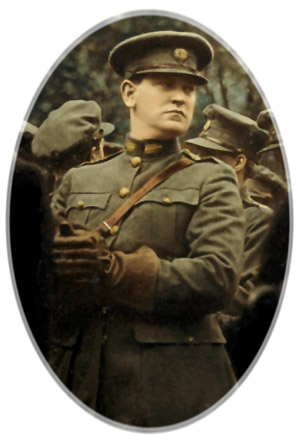It was in October of 1922 that the Irish Army Council decided to organise a census of National Forces, to be undertaken at midnight spanning the 12th & 13th November of that year. Its purpose was “To ascertain the exact strength of the National Forces by location, for administrative, logistical and operational purposes.”
Today, a full list of personnel in the Free State Army originally led by General Michael Collins is being currently launched on-line, on the website of the Defence Forces’ Military Archives.
When the site is complete the full contents of Ireland’s first, and indeed only military census, which was compiled just months after General Collins was killed in 1922, will list the names of all those who served in the Irish National Army, during the Civil War.
The then National Army consisted of units of the IRA who had fought for independence from Britain. Their Commander in Chief was General Collins, who was also the Chairman of the new Provisional Government of the Irish Free State, which was scheduled to materialise in December 1922. However this expected transition to Irish independence was to be disrupted by the Irish Civil War, which began in June 1922. This new army would now split between those who supported the Treaty and the “Irregulars,” latter, those who opposed it.
Following his death in an ambush by ‘Irregulars,’ at Béal na mBláth, Cork in August 1922, General Michael Collins was replaced as head of the provisional government, between August to December 1922, by William Thomas Cosgrave. (Though it had the option to appoint General Richard Mulcahy, the pro-Treaty leadership decided on W. T. Cosgrave to succeed, in part due to his democratic credentials as a long-time serving politician.)
A sample on-line page listing named individuals in the barracks at Borrisoleigh, Thurles, Co Tipperary, can now be viewed by clicking Here or visiting the ‘Links Category,’ shown on the right hand side of our sister site Hidden Tipperary under ‘Irish Army Census 1922.’


The term ‘Irregulars’, commonly used by more recent commentators on the Irish Civil War than had been the case in the past, was at the time and for decades after considered extremely derogatory and insulting by anti-Treaty forces. Designed for the press, radio and the pub in an effort to normalise within the general public opinion that those, who for various reasons rejected the Treaty as it stood in 1922, were nothing more than troublesome (and armed) nay-sayers (Remembering that the Treaty was only narrowly ratified by 64 votes to 57).
The Treaty and the new Provisional Government established in 1922 contained a curious political anomaly: the coexistence for several months in 1922 of a President of the Dáil Government (Arthur Griffith who stepped in after Dev resigned) and a Chairman of the Provisional Government (Michael Collins)! confusing isn’t it?…
This was a deliberate attempt by the new regime to claim legitimacy in the eyes both of Irish Republicans and British politicians (a sort of fudge to the complete incompatibility between these positions). This attempt to turn two ways at once presented the state with fundamental challenges from both directions. I have read from Dan Breen transcripts that senior Anti-Treaty IRA officers, mostly from Tipperary (including Dan Breen, Dinny Lacey, Todd Andrews, Seán Gaynor, Frank Barrett and Liam Lynch) met to discuss the implications of the deal.
They suggested that the new regime offended those republicans who took the view that the Proclamation of a Republic in 1916 and it’s confirmation by the Dáil in 1919 were irreversible. They regarded the Free State as a hideously deformed alternative to ‘the Republic’ deficient not only because it represented a truncation of the ‘national territory’ but also because it retained important links of subordination to the United Kingdom, at least at a symbolic level. These and other issues split Sinn Féin’s IRA into two groups; pro and anti Treaty.
For any military group, and as we know those who opposed the Treaty were predominately veterans of the War of Independence, the term ‘Irregular’ tends to imply non-regular, unofficial, disorganised, an almost leader-less rabble which was certainly not the case. I think that at the time those military elements in opposition to the Treaty as it stood in 1922 termed themselves IRA Anti-Treaty Forces.
Lets not slide further into the murky world of historical speculation and allegation. One such speculation which I have been interested in for years, though almost impossible to prove, is the theory that the Irish Civil War was a convenient front for the unofficial policy of literally killing-off any senior or influential figures within the IRA Anti-Treaty Forces whom the Provisional Government felt..(encouraged and approved by Britain’s political and financial elites and Irish ‘neutral’ property and banking interests).. had any left leaning political aspirations in the tradition of James Connolly and Jim Larkin. With this left-leaning intellectual neucleus of ‘men of no property’ permanently removed from future Irish politics, the road ahead was clear for centre-right politics supported by property and capitalism to dominate Irish politics for…. well ever since really.